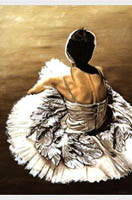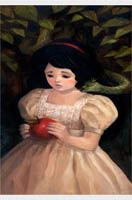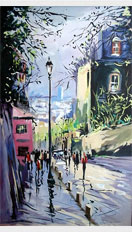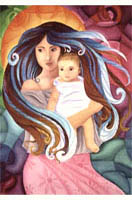Isaac Levitan
 |
Personal Details:
|
Isaac Levitan (1860-1900) was a famous Russian painter renowned for his expressive and evocative landscape paintings and his dedication to capturing the beauty of the Russian countryside. He was a leader of the late 19th century movement of Russian Realism, and his work has had a lasting impact on the development of Russian art.
In 1875, his mother died, and his father got seriously ill (he died in 1877) and became unable to support four children. The family slipped into abject poverty. As a patronage for Levitan's talent and achievements and to keep him in the school, he was given a scholarship.
Autumn day. Sokolniki. 1879In 1877 Isaac Levitan's works were first
publicly exhibited and were positively recognized by the press.
In May 1879, mass deportations of Jews from big cities of Russian
Empire forced the family to move to a suburb Saltykovka, but in
the fall, with the pressure on the officials from the art devotees,
Isaac Levitan was allowed back. In 1880 his painting (Autumn day.
Sokolniki) was bought by famous philanthropist and art collector
Pavel Mikhailovich Tretyakov. (See also Tretyakov gallery)
In the spring 1884, Levitan participated in the mobile art exhibition, also known as the Peredvizhniki and since 1891 became a member of the Peredvizhniki partnership. During the study in the Moscow School of painting, sculpturing and architecture Levitan befriended Konstantin Korovin, Mikhail Nesterov, architect Fyodor Shekhtel, painter Mikhail Chekhov, his famous brother writer Anton Chekhov who became the closest friend of the artist for life. Levitan often visited Chekhov and some think Levitan was in love with his sister, Maria Pavlovna Chekhova.
Levitan's work has had a lasting impact on Russian art. His paintings of the Russian countryside remain some of the most beloved works of art in the country, and his influence can be seen in the works of his students and followers, such as Ilya Repin and Valentin Serov. His dedication to capturing the beauty of the Russian countryside has also inspired generations of painters to pursue the same goal. In summary, Isaac Levitan was a renowned Russian painter who dedicated his life to capturing the beauty of the Russian countryside. He was a leader of the late 19th century movement of Russian Realism, and his work has had a lasting impact on the development of Russian art. His paintings of the Russian countryside are some of the most beloved works of art in the country, and his influence can be seen in the works of painters who followed in his footsteps.
Shore 1889In the end of 1880s he visited the "drawing evening" in the Polenov’s house. The landscape painter, deeply feeling both lyrical revealing unique charm and quiet greatness of Russian nature, Levitan practically did not paint urban landscapes, with the exception (currently lost) "View of Simonov monastery", mentioned by Nesterov, Moscow is present only in the painting "Illumination of the Kremlin". In the end of 1870s he worked a lot in vicinities of Moscow, and created the special variant of "landscape of mood" in which the shape and a condition of the nature are spiritualized, become carriers of conditions of human soul ("Autumn day. Sokolniki", 1879). During work in Ostankino, he embodied fragments of mansion’s house and park, but basically he was fond of poetry chamber places in forest or modest countryside.
Levitan's work has had a lasting impact on Russian art. His paintings of the Russian countryside remain some of the most beloved works of art in the country, and his influence can be seen in the works of his students and followers, such as Ilya Repin and Valentin Serov. His dedication to capturing the beauty of the Russian countryside has also inspired generations of painters to pursue the same goal. In summary, Isaac Levitan was a renowned Russian painter who dedicated his life to capturing the beauty of the Russian countryside. He was a leader of the late 19th century movement of Russian Realism, and his work has had a lasting impact on the development of Russian art. His paintings of the Russian countryside are some of the most beloved works of art in the country, and his influence can be seen in the works of painters who followed in his footsteps.







